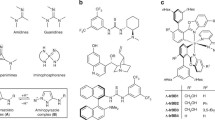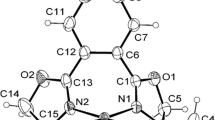Abstract
The chirality-organized quinonediimine derivatives bearing amino acid moieties were demonstrated to react with 2 molar equiv. of Pd(OAc)2, resulting in the formation of the chiral homobimetallic palladium(II) complexes. The crystal structures of the chiral conjugated complexes revealed the coordination of the quinonediimine nitrogen to a palladium center and a chiral propeller twist conformation of the π-conjugated backbone. The mirror image relationship of the CD signals around the quinonediimine moieties in acetonitrile was observed between l- and d-derivatives, indicating the preservation of the chirality-organized structures even in a solution.



Similar content being viewed by others
Notes
See also the Nobel lectures of Heeger et al.[3].
CCDC 888392 (2- L) and CCDC 888393 (2- D) contain the supplementary crystallographic data for this paper. These data can be obtained free of charge from The Cambridge Crystallographic Data Centre via www.ccdc.cam.ac.uk/data_request/cif.
References
A.J. Epstein, J.M. Ginder, A.F. Richter, A.G. MacDiarmid, in Conducting Polymers, ed. by L. Alcacer (Elsevier, Reidel, 1987), pp. 63–70
W.R. Salaneck, D.T. Clark, E.J. Samuelsen, Science and Application of Conductive Polymers (Adam Hilger, New York, 1990)
A.J. Heeger, A.G. MacDiarmid, H. Shirakawa, Angew. Chem. Int. Ed. 40, 2574 (2001)
B.J. Holiday, T.M. Swager, Chem. Commun. (1), 23–36 (2005)
M.O. Wolf, J. Inorg. Organomet. Polym. Mater. 16, 189 (2006)
P. Nguyen, P. Gómez–Elipe, I. Manners, Chem. Rev. 99, 1515 (1999)
W.-Y. Wong, C.–.L. Ho, Coord. Chem. Rev. 250, 2627 (2006)
T. Hirao, Coord. Chem. Rev. 226, 81 (2002)
T. Moriuchi, T. Hirao, Acc. Chem. Res. 45, 347 (2012)
M. Higuchi, D. Imoda, T. Hirao, Macromolecules 29, 8277 (1966)
M. Higuchi, I. Ikeda, T. Hirao, J. Org. Chem. 62, 1072 (1997)
T. Hirao, S. Yamaguchi, S. Fukuhara, Tetrahedron Lett. 40, 3009 (1999)
T. Hirao, S. Yamaguchi, S. Fukuhara, Synth Met. 106, 67 (1999)
T. Moriuchi, M. Miyaishi, T. Hirao, Angew. Chem. Int. Ed. 40, 3042 (2001)
T. Moriuchi, M. Kamikawa, S. Bandoh, T. Hirao, Chem. Commun. 14, 1476 (2002)
T. Moriuchi, S. Bandoh, M. Miyaishi, T. Hirao, Eur. J. Inorg. Chem 113, 651 (2001)
T. Moriuchi, X. Shen, K. Saito, S. Bandoh, T. Hirao, Bull. Chem. Soc. Jpn. 76, 595 (2003)
X. Shen, T. Moriuchi, T. Hirao, Tetrahedron Lett. 44, 7711 (2003)
T. Moriuchi, J. Shiori, T. Hirao, Tetrahedron Lett. 48, 5970 (2007)
X. Shen, T. Moriuchi, T. Hirao, Tetrahedron Lett. 45, 4733 (2004)
T. Moriuchi, X. Shen, T. Hirao, Tetrahedron 62, 12237 (2006)
S.D. Ohmura, T. Moriuchi, T. Hirao, J. Org. Chem. 75, 7909 (2010)
T. Moriuchi, S.D. Ohmura, K. Morita, T. Hirao, Chem. Asian J. 6, 3206 (2011)
T. Moriuchi, S.D. Ohmura, K. Morita, T. Hirao, Asian J. Org. Chem. (in press)
Y. Ma, C.S. Day, U. Bierbach, J. Inorg. Biochem. 99, 2013 (2005)
Acknowledgments
This work was supported by Grant-in-Aids for Science Research on Innovative Areas (Nos. 23111711 and 24108722) from the Ministry of Education, Culture, Sports, Science and Technology, Japan. One of the authors SDO acknowledges a JSPS fellowship for young scientists.
Author information
Authors and Affiliations
Corresponding authors
Additional information
This paper is dedicated to Prof. Dr. Hiroshi Nishihara for his outstanding contribution to the field of metal-containing polymers.
Electronic Supplementary Material
Below is the link to the electronic supplementary material.
Rights and permissions
About this article
Cite this article
Ohmura, S.D., Moriuchi, T. & Hirao, T. Chiral Homobimetallic Palladium(II) Complexes Composed of Chirality-Organized Quinonediimines Bearing Amino Acid Moieties. J Inorg Organomet Polym 23, 251–255 (2013). https://doi.org/10.1007/s10904-012-9733-5
Received:
Accepted:
Published:
Issue Date:
DOI: https://doi.org/10.1007/s10904-012-9733-5




